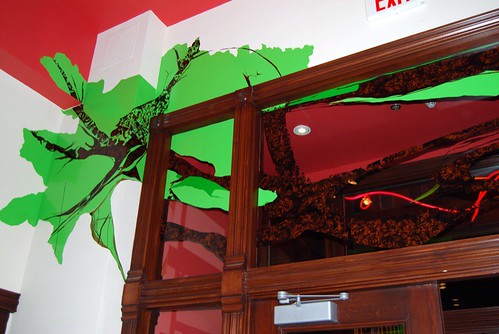
Wednesday, October 22, 2008
Tuesday, October 21, 2008
TTC St. Clair Project

OK. I have been twisting my brain to learn illustrator. This is really not bad because I am realizing that while it is much more labor intensive it is a much better drawning tool. I will upload some of these experiments when I can figure out how to do that! In the mean time...this is my first conceptualization for the shelter. I am not finished but feeling good about it.
Friday, October 03, 2008
Ordinary People: Nuit Blanche Toronto
Ordinary People - Nuit Blanche
Forwarded Press Release
Public Action during Nuit Balnche
A call for action to all ordinary people from ordinary people.
Toronto, Ontario Oct 03, 2008 "I think when ordinary working people come home, turn on the TV and see a gala of a bunch of people at, you know, a rich gala all subsidized by taxpayers claiming their subsidies aren't high enough, when they know those subsidies have actually gone up - I'm not sure that's something that resonates with ordinary people," Harper said in Saskatoon, where he was campaigning for the Oct. 14 election.
The artist collective Ordinary People rejects the recent statements made by Prime Minister Stephen Harper and calls upon ordinary people to show their support of the arts. This is a call for action to all ordinary people from ordinary people.
At midnight on Saturday, October 4th we ask you to STOP for 4 minutes 33 seconds and hold up a piece of paper displaying the word ART. (John Cage, 4'33")*
In his first detailed defense of $45-million in controversial cuts to arts and culture funding, Conservative Leader Stephen Harper called his party's decisions good governance and said the government must walk "a fine line" between providing financial stability and "funding things that people actually don't want."
Mr. Harper himself took the piano "very seriously" and eventually passed the Royal Conservatory of Music's Grade 9 examinations, demonstrating considerable proficiency at the keyboard, and said that although he "had a bit of talent," he was held back because his hands shook when he was nervous, a trait he later outgrew. "For the first half year I was in lessons, we didn't have a piano and I would actually practice for my lessons on a cardboard keyboard, so I would only hear it for the first time when I actually sat down and had the lessons," he said. IN RECOGNITION OF MR. HARPER'S EARLY INTEREST, "ORDINARY PEOPLE" HAVE CHOSEN A PIANO WORK BY JOHN CAGE FOR THIS DEMONSTRATION.
4'33" (Four minutes, thirty-three seconds) by composer John Cage
4'33" (Four minutes, thirty-three seconds) by composer John Cage instructs the performer not to play the instrument during the entire duration of the piece. Although commonly perceived as "four minutes thirty- three seconds of silence", the piece actually consists of the sounds of the environment that the listeners hear while it is performed.
About "Ordinary People"
The artist collective, Ordinary People believes that everyone benefits in a society that respects and promotes culture. Ordinary People includes students from the Ontario College of Art & Design and the internationally renowned artist ORLAN. We ask that you distribute this as fast as you can, by however means. We thank you
Ordinary People Artist Collective
forwarded by Christina Zeidler
e-mail: christina@gladstonehotel.com
We ask that you distribute this as fast as you can.
We thank you
ordinarypeoplecollective@live.com
Email Marketing by
Christina Zeidler | 1214 Queen St. West | Toronto | Ontario | Canada
Thursday, September 18, 2008
My Ontario Haiku from Amos

The other day I posted about Amos Latteier's project N8R TXT...this morning I texted my location and this is the haiku I received generated in lightening speed:
Summer morning,
riverdale park, toronto
--
downtown Toronto/ close 2 Lockheed Blvd/
wasps at the screen door
I may try another one this afternoon!
Here is Amos's statement about the project:
Cell phones are a common element of the Ontario landscape. We often think of phones as devices that isolate people from their surroundings, but I want to demonstrate that they can be used to connect people to their environments. N8R TXT tries to use technology and humour to give people a fresh perspective on their environment, and provide them with an occasion to look more closely at their surroundings. I believe that our world is full of unexpected pleasure and hybrid splendour.
I gratefully acknowledge the Ontario Arts Council's support of this project. You guys rock.
-Amos Latteier
Contact
Amos Latteier
http://latteier.com/
416-532-4010
Friday, September 12, 2008
more inspiration...
Black Blossom Wallpaper Panel
Posted Nov 11th 2006 4:04PM by Nicole Weston
Filed under: Decor
 Forget about trying to cover entire walls with wallpaper or paneling. It is much more fashionable to use wall tattoos or something similar to accent the room without taking it over. The Black Blossom Wallpaper Panel works in the same way, as it only covers a small portion of the room, acting more as artwork than just a wall covering. The blossom design is hand-stitched onto vintage wallpaper and is accented with screen printed images to lend coloring and additional depth. The panels measure 22" x 118" and are mounted on a rod, rather than applied directly to the wall. Price: £1,160.00 ($2,210).
Forget about trying to cover entire walls with wallpaper or paneling. It is much more fashionable to use wall tattoos or something similar to accent the room without taking it over. The Black Blossom Wallpaper Panel works in the same way, as it only covers a small portion of the room, acting more as artwork than just a wall covering. The blossom design is hand-stitched onto vintage wallpaper and is accented with screen printed images to lend coloring and additional depth. The panels measure 22" x 118" and are mounted on a rod, rather than applied directly to the wall. Price: £1,160.00 ($2,210).
Tags: black blossom, decor, panel, paper, wall panel, wall paper, wallpaper
What a cool idea!
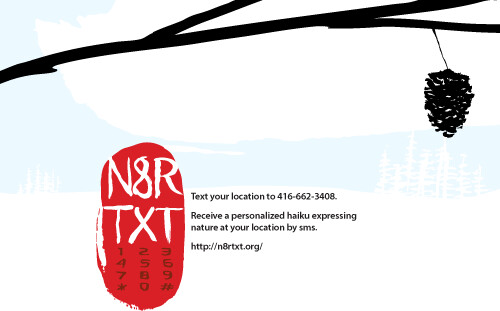
Toronto artist Amos Latteier has just launched N8R TXT, a public art project where you can send in an SMS with your location, anywhere in Ontario, and receive back a site specific haiku “expressing nature” at that spot based on the local geography, season, weather, time of day, plants, and animals. Here’s how it works:
Text your location to 416-662-3408. Locations should include the name of your city, and must be in Ontario, for example: “100 queen w, toronto”, “hamilton”, “laurier & elgin, ottawa”.
Some examples:
“Summer evening, bloor & landsdowne, toronto”
slumpd in the subwy
ladybird beetls nappng
rusticatd stone“Summer morning, lake simcoe”
these yello pebbles
a bug hat, or bug jacket
beside a dirt road“Summer night, Toronto”
bneath the lamplite
hardly nything open
small town Toronto
It’s free (only costs whatever your mobile plan charges to send a text) and is quite lovely. Latteier often investigates the intersection of nature and technology — check out his project Call of the Wild, “Cell phone audio tours of downtown Portland wildlife” — and you also may remember his Pigeon Condo project back in 2006 at Yonge and the Gardiner. With N8R TXT it’s remarkable how sweet the machine generated haiku poems can be. Latteier writes:
Historically haikus are themed around season and place. They also traditionally employ a technique called “cutting” which is basically juxtaposition. I tried to write my poem generating program to follow those techniques. Of course it also uses juxtaposition by bringing together “high” and “low” language and by connecting consumer electronics with “nature”.
You can follow recent activity on the site itself via RSS feed, or subscribe to the Twitter feed. Even when it’s not your personal haiku, it gives a neat snapshot of artful moments around the city as people go about their business. Put the number in your phone’s contact list and text away wherever you are.
Wednesday, September 10, 2008
dimensionality...
- VIDEO: Exclusive from Art21
Matthew Ritchie | “The Morning Line”
EXCLUSIVE: Matthew Ritchie discusses his upcoming exhibition The Morning Line (2008) in his New York studio, with animated architectural schematics of the installation. The Morning Line will be on view October 2, 2008 - January 11, 2009 at the Centro Andaluz de Arte Contemporáneo in Seville, Spain, as part of the 3rd Bienal Internacional de Arte Contemporáneo de Seville.
Matthew Ritchie’s artistic mission has been no less ambitious than an attempt to represent the entire universe and the structures of knowledge and belief that we use to understand and visualize it. Ritchie’s encyclopedic project (continually expanding and evolving like the universe itself) stems from his imagination, and is cataloged in a conceptual chart replete with allusions drawn from Judeo-Christian religion, occult practices, Gnostic traditions, and scientific elements and principles.
Matthew Ritchie is featured in the Season 3 (2005) episode Structures of the Art:21—Art in the Twenty-First Century television series on PBS.
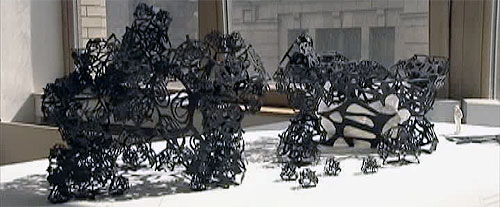
ART21: What are you aiming for the viewer to experience with your work?
RTICHIE: What I’m aiming for is to describe the whole spectrum of experience, simultaneously. There are an enormous number of things in the world that we know about, and there are an exponentially larger number of things that we don’t know about. And those things that we don’t know about affect the things that we think we know about all the time. So we have our daily experience, and we go through our day and things happen the way that we think they’re supposed to happen (sort of). But when something changes, we automatically accommodate to that change and read it as part of our life. This is the narrative of a person’s life, and one of the ways that we describe what’s going on is we tell stories. We always tell the stories after things have happened, not before. There is no real story of what’s going to happen next. But once something’s happened there’s always a story about how and why and what the reasons were.
In one sense what I’m trying to do is create a manual of all the codes — all the stories that have ever been told — or a way to read all those stories through a lens. What are those stories trying to describe? They’re all trying to describe the same thing, which is how everything works. Why is it, on any given day, one person crosses a street and has a great day, and another person crosses the street and is hit by a car and that’s the end of their life? We’re always trying to make sense of this dramatic shift in, this incredible potential for all of these vast, unknown forces to suddenly reach through — reach out — and touch you and that’s it. It’s always in the air, for all of us. This could be the day you win a million dollars, or the day your life is over.
So in a way these things that I’m making could be thought of as meaning machines that take apart all the stories, lay out all the parts in front of you, and then allow you to choose one little piece of the story. Instead of it being chosen for you by the forces of fate, I lay out the parts and say, “Here, you can actually pick this up and have a look at it.” See what it’s made of? Tap it on the table, bite it a little bit. See what’s going on with this piece of fortune.
A good metaphor is a pack of Tarot cards — in itself it’s not a story, but lay out the cards and it always tells a story. What I’m trying to do is give people a sense of control over the narrative. A story is not any more real or less real than anything else. A story is just something you do with your brain. It’s a function — like walking — you tell stories wherever you go. And stories are all made up of pieces. And you can change the way you understand the story by changing the way you understand the pieces. And if you can do that, in a sense you’ve changed the dynamic of how you relate to reality.
The piece The Morning Line (2008) is like a frozen piece of reality. It’s like in the movies, where everyone’s suddenly turned into a statue and only you can walk around the world. You can look behind the scenes where the puppet master is controlling everything. I’m trying to show you what’s going on, like a magician showing you his trick in slow motion: this is what it looks like when you stop everything and look at the parts you can’t see.
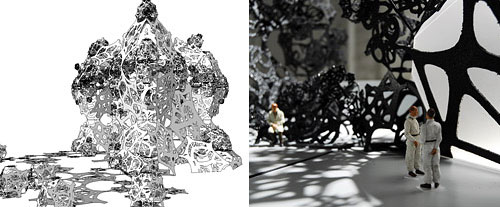
ART21: Where does the title for the piece come from? And what’s its relationship to music?
RTICHIE: The Morning Line takes its title from a British racing paper. It has the lineup of the day — all the horses — and what they’re going to accomplish. But to me it’s also a reference to the beginning of a new day, when everything is a new possibility.
The Morning Line building is really a gigantic musical instrument. It’s programmed with a series of scores that are based on the Medieval idea of polyphony, which is multiple sliding tracks that have a specific relationship to each other, but to the listener, the tracks always seem to be moving past each other. When polyphony was first invented, it was believed to be the Devil’s music because of its possibility for multiple interpretations. Instead of a very rigid set of canonical moves forward, you can actually have lots of different things happening at the same time. It’s about this idea of multiple voices.
Every time you come back to The Morning Line, not only does the piece track you through various technologies and produce sounds that move around you, but it’s constantly reorganizing its own musical mind. It will sing you a different song or tell you a different story every time you go through, which goes back to this idea that there’s always another story, but it’s always the same story.
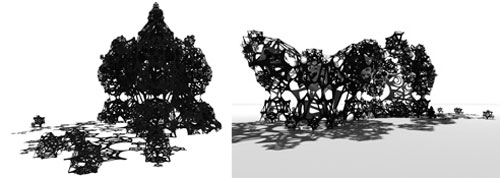
ART21: The Morning Line is a physical building, and yet it comes out of an interest in drawing, in scale, in fractals. Is there a tension between the flat one-dimensionality of drawing and architecture in three dimensions?
RITCHIE: Initially the project was to take this idea of drawing, which I was experimenting with in smaller architectural pieces, and ask “Can you make a drawing that’s in a space as big as the world? Can you draw in space?” If you’re going to draw in space, your drawing has to be supported by all the rules of reality. For what I wanted to do, it meant designing a structure out of parts and each of the parts replicates itself at smaller and smaller scale. You can take this down and down and down, all the way into the nano spectrum from the size of a cathedral. We don’t need to think about a given building as having a single frame of reference, which is the size of a human being who’s going to go through the door, use the washroom, and sit down at a table and a chair. I want to think about a building that is designed for the universe to occupy it — the same way it occupies everything else — which is to say at every single scale simultaneously.
It’s a kind of trick that people have been trying to do for 3,000 years, though they never succeeded in solving the geometry of making a structure of this kind scale in three dimensions. There are drawings going back to Plato of this kind of geometry working as a model of the universe, but no one could ever make it because they didn’t have computers
The Morning Line is built out of what’s called a truncated tetrahedron, which is a pyramid with the corners chopped off. If you look past the tetrahedron shape and consider just the surface of it — the drawing on the surface — every point in this sculpture attaches to another point. The line becomes an infinitely recursive form moving through space. You can start to draw a trajectory with it. You’re drawing a journey, and a journey is always the thing that I’m most interested in.
We’ve sort of grappled with what to call The Morning Line structure. You could call it a quantum building, because any one of these tetrahedra can support across its surface twenty-two other smaller tetrahedra of the next scale down and so on. It can grow like a crystal, infinitely smaller in any direction. You could also call it a holographic building, because the premise of holographic theory is that the universe is the same at every scale. Just like a hologram — if you break it — it has a million little tiny holograms inside, all the way down.
The idea is that at every level it maintains the same integrity, but it also maintains the property of the drawing, which is that every little point will always connect to every other little point. There’s always a connection. It’s not just about bricks; it’s about lines moving through space and connecting to the next level down. The journey moves through scale. There’s a connection between the speck of dust that gets into the brake line and jams the brakes of the car that doesn’t stop in time to knock someone over in the road. In the end it all comes back down to a speck of dust. Shakespeare’s famous “my kingdom for a horse.”
VIDEO | Producer: Eve Moros Ortega and Nick Ravich. Camera: Joel Shapiro. Sound: Judy Karp. Editor: Mary Ann Toman. Artwork Courtesy: Matthew Ritchie and Aranda/Lasch. Thanks: Benjamin Aranda.
PHOTO | All works: Matthew Ritchie and Aranda/Lasch, studies for the The Morning Line, 2008.
Ideas for...
By Ezra Natalia


Prior to graduating from the Konstfack University of Arts, Crafts and Design in Stockholm, textile designer Hanna Nyman already had the interior industry’s attention for her intricately-designed wallpapers. Hanna works mostly with patterns that change shape, as she enjoys the tension when something beautiful transforms into something new or acquires an unexpected function. This is clearly evident in her work.
Floral patterns emerge from the paper's surface and her wallpapers become three-dimensional. Even better, the wallpaper is designed so that each user peels back a select section of the wall allowing customization of the the pattern and giving each wall its own identity. Hanna also designs origami sculptures and lights to enhance texture and interactivity within a space.
Inspired by the poem "Skogen Skapar" by Ann Jäderlund, which Hanna interprets as "a crazy story about strange things happening in the forest, like an urban jungle," she uses her own work to tell stories. "My work is narrative rather than functional."

Check out Nyman's work currently being exhibited at A World of Folk, a design and craft fair in Norway. More info is available on her website and contact her directly to inquire about purchasing her wallpapers.
More images after the jump.


Monday, August 11, 2008
Kid's Trunk Show at the WorkRoom

the workroom
1340 Queen Street West
Sunday August 17
12-5pm 15 local vendors selling handmade goodies. A wonderful assortment of
treasures for the youngsters in your life (or in you)... everything from
crocheted ice cream cones, illustrated colouring books, play capes, party invitations and ‘on the go’ change mats. Have a watercolour portrait done on the spot or decorate your own delicious cupcake at the cupcake decorating station.
DEBBIE ARRUDA
ANGELUNE DES LAURIERS
SHANNON GERARD
GIRL NUMBER TWENTY
GRANDMA INDUSTRIES
TANIA HOWELLS
ELLA KOHLMANN
MEGHAN KRAATZ
LEILABUG TOYS
LUNULE
OLD WESTON HOME FOR WANDERING BEARS
OPERATION SOCK MONKEY
PATOUCHE
ZEESY POWERS
VINTAGE PAPER PARADE
YoGA QuEEn
1273A Queen Street West
12-4pm: Drop in to make Yoga Crowns & Wish Flags or to participate
in Yoga Games and Songs. Activities will rotate every half hour.
shoP GirLs
1342 Queen Street West
1 day sale on Lino Baby clothing for children
1pm: Sock Monkey Making workshop with Operation Sock Monkey
Learn to make a cute sock monkey and benefit a worthy cause,
“Clowns without Borders”. Donate your sock monkey at the end
of the workshop or pay $15 to take your new friend home.
Wednesday, July 09, 2008
What's New?
My decals for kids are included in this month’s Poppytalk Handmade Market (July 7 through August 6)! Peruse my stall here or all the super-crafty items in the market here. I was going to try to choose some favorites but all of the work deserves a peek!
In the months to come, I will be setting up shop at Hoopla, a mother and baby focused market. I will have more decals, my “on the go change mat” that was included in Making Stuff for Kids, and flip chair for kids that has 2 heights and can be used a small table, chair, bookshelf, and game table (depending on the finish you choose).

On the art front, I will do an installation for Relative Space and Floorworks (365 Dupont, Toronto) from November 17th until February 13, 2009. I was also selected for the proposal stage conceptualization for public art at a transit station on Toronto’s new streetcar line along St. Clair Avenue so I am riding the streetcar and thinking about shelters and transparency!
Thursday, March 06, 2008
Tuesday, February 19, 2008
I love it, I hate it, it's swell...


tonight is the last night of installation...i am looking forward to finishing...one more day of cutting and then synthetic grass on Wednesday and some time to breathe...
Wednesday, February 13, 2008
Progress

So far things are going slowly but I am happy with the results. Installation starts on Sunday so my time is dwindling. I love the pressure I hate the pressure.
Wednesday, January 30, 2008
Wednesday, January 23, 2008
Palm of the hand nature




Ok. Feeling better about this now. I want to explore in a 2-d way, "constructed" nature, in the vaguely pleasing way that we veil the trappings of contemporary life in nature or in the 'form' of nature--cellular trees, camouflage, resin cast stumps of wood, and in the 2-d world, wood-grain mac tac, fabrics, and auto detailing vinyl, waterfalls in the east river (that is a bit more high tech), terrariums, we are copying nature as we are losing nature...just need to decide which drawing looks the best. Thinking about ikebana and astroturf.
Breathtaking

Taking a break from trees with trees. From Flavorpill by way of Ministry of Type (where you can watch the animation) by way of Fubiz from the Japanese design firm WOW10.
The artwork is by Shun Kawakami, Illustration, Suibokuga, Drawing by Tadashi Ura and the photography by Taisuke Koyama.
Still imagery at Artless
Friday, January 18, 2008
Friday


Decided not to drive out to buy the vinyl until I had a design that I actually liked! Here is today...still need to think. Next week will be the vinyl excursion.
Thursday, January 17, 2008
It is important to have enough...
Silkscreening on rug did not work very well but paint did which is a bit of a relief because it is much easier for me to do. I just have to decide whether acrylic or spray paint. More experiments.





